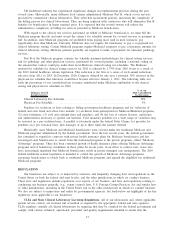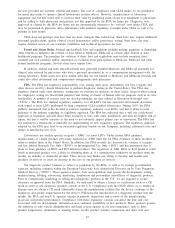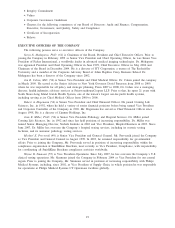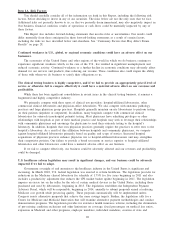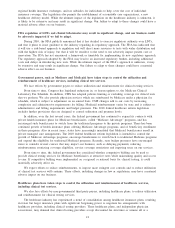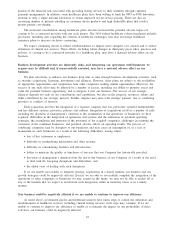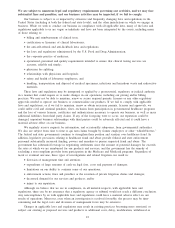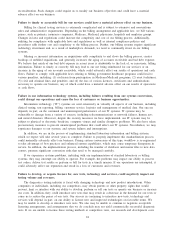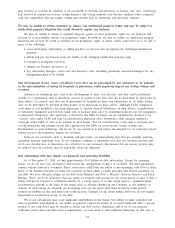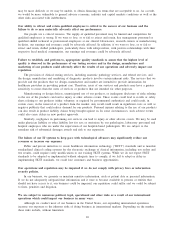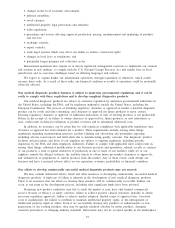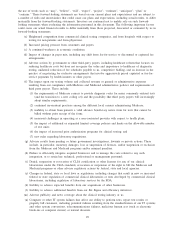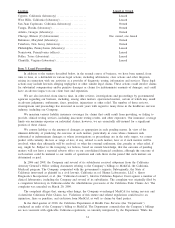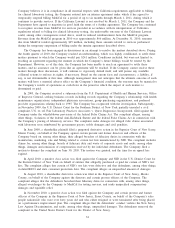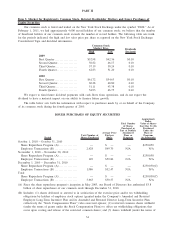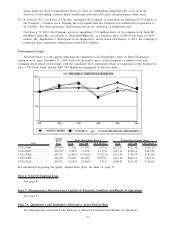Quest Diagnostics 2010 Annual Report Download - page 28
Download and view the complete annual report
Please find page 28 of the 2010 Quest Diagnostics annual report below. You can navigate through the pages in the report by either clicking on the pages listed below, or by using the keyword search tool below to find specific information within the annual report.may increase as a result. In addition, if we are unable to develop and introduce, or license, new tests, technology
and services to expand our esoteric testing business, our testing methods may become outdated when compared
with our competition and our testing volume and revenue may be materially and adversely affected.
We may be unable to obtain, maintain or enforce our intellectual property rights and may be subject to
intellectual property litigation that could adversely impact our business.
We may be unable to obtain or maintain adequate patent or other proprietary rights for our products and
services or to successfully enforce our proprietary rights. In addition, we may be subject to intellectual property
litigation and we may be found to infringe on the proprietary rights of others, which could force us to do one or
more of the following:
•cease developing, performing or selling products or services that incorporate the challenged intellectual
property;
•obtain and pay for licenses from the holder of the infringed intellectual property right;
•redesign or reengineer our tests;
•change our business processes; or
•pay substantial damages, court costs and attorneys’ fees, including potentially increased damages for any
infringement held to be willful.
The development of new, more cost-effective tests that can be performed by our customers or by patients,
or the internalization of testing by hospitals or physicians, could negatively impact our testing volume and
revenues.
Advances in technology may lead to the development of more cost-effective tests that can be performed
outside of a commercial clinical laboratory such as (1) point-of-care tests that can be performed by physicians in
their offices, (2) esoteric tests that can be performed by hospitals in their own laboratories or (3) home testing
that can be performed by patients in their homes or by physicians in their offices. Although CLIA compliance
costs make it cost prohibitive for many physicians to operate clinical laboratories in their offices, manufacturers
of laboratory equipment and test kits could seek to increase their sales by marketing point-of-care test equipment
to physicians. Diagnostic tests approved or cleared by the FDA for home use are automatically deemed to be
“waived” tests under CLIA and may be performed in physician office laboratories with minimal regulatory
oversight under CLIA as well as by patients in their homes. Test kit manufacturers could seek to increase sales
to both physicians and patients of test kits approved by the FDA for point-of-care testing or home use.
Development of such technology and its use by our customers would reduce the demand for our laboratory-based
testing services and negatively impact our revenues.
Some of our customers, such as hospitals and physicians, are internalizing tests that we currently perform,
including anatomic pathology tests. If our customers continue to internalize tests that we currently perform and
we do not develop new or alternative tests attractive to our customers, the demand for our testing services may
be reduced and our revenues may be materially adversely impacted.
Our outstanding debt may impair our financial and operating flexibility.
As of December 31, 2010, we had approximately $3.0 billion of debt outstanding. Except for operating
leases, we do not have any off-balance sheet financing arrangements in place or available. Our debt agreements
contain various restrictive covenants. These restrictions could limit our ability to use operating cash flow in other
areas of our business because we must use a portion of these funds to make principal and interest payments on
our debt. We have obtained ratings on our debt from Standard and Poor’s, Moody’s Investor Services and Fitch
Ratings. There can be no assurance that any rating so assigned will remain for any given period of time or that a
rating will not be lowered or withdrawn entirely by a rating agency if in that rating agency’s judgment future
circumstances relating to the basis of the rating, such as adverse changes in our Company or our industry, so
warrant. If such ratings are lowered, the borrowing costs on our senior unsecured revolving credit facility,
secured receivables facility and term loan could increase. Changes in our credit ratings, however, do not require
repayment or acceleration of any of our debt.
We or our subsidiaries may incur additional indebtedness in the future. Our ability to make principal and
interest payments will depend on our ability to generate cash in the future. If we incur additional debt, a greater
portion of our cash flows may be needed to satisfy our debt service obligations and if we do not generate
sufficient cash to meet our debt service requirements, we may need to seek additional financing. In that case, it
25


